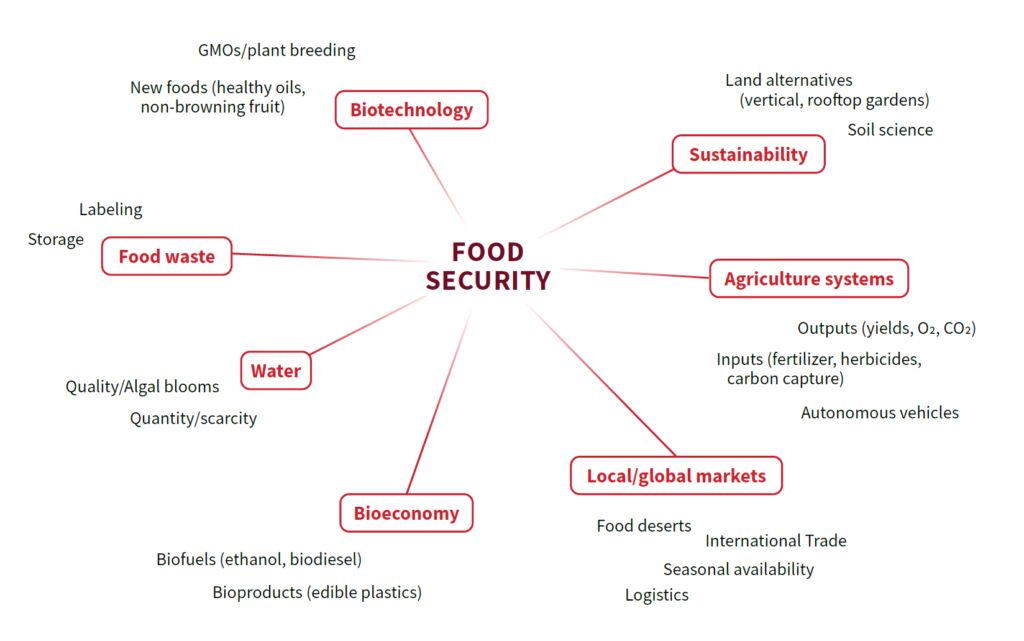Leading a design challenge can be daunting, especially when the problem is complex and wide-ranging. This year’s Ohio Design Challenge is no different:
Work as a team to imagine, design and prototype a solution to increase food security in your life, community, or world.
Food security can cover issues like how we grow food, how we transport it, and how it’s distributed.
With a topic this big, students can get stuck. One of the best ways to help is to narrow the focus. Move the frame of the question from something as big as food insecurity down to one of the several smaller, related issues. This will help provide some structure and support to help students arrive at authentic, real-world solutions. To help us understand how to use a design brief and effectively narrow the focus of a design challenge, we talked about the following ideas with Metro Early College Middle Science Teacher Erika Reeves.
First, get oriented
You’ll want to spend some time orienting yourself and your students to the challenge of food insecurity. What does it mean to have food security? What is food insecurity? Why does it matter? Who faces this problem? What are the contributing factors to food insecurity? This is the part where you help build empathy. Your students should begin to see how this problem applies to them and why they should work on it at all.
Identify one facet your class will address
After you learn a bit about the problem, you can focus one one facet of the problem. In an earlier blog, we shared this graphic to help you start thinking about some of the ways food security relates to agriculture and access to food. That web is not a comprehensive list, but it a good place to start narrowing your focus and help you define an even MORE specific problem within food security to solve.
For example: You could direct your class to just consider solutions around local/global markets for food.
Or solve the issue for one specific audience
Another way to narrow the focus is to identify a particular audience that you are creating a solution for. This will lead to more specific, refined solutions. Students can empathize with the people who have the problem and create genuine solutions. Many times, students personally know individuals who are challenged by the problem they want to solve. Students can begin the process by creating a needs statement.
Examples:
- Ohio farmers need to create new foods to grow so we can have enough food in 2050.
- Families need to reduce food waste so there is more food to go around.
- Restaurants need a better way to store produce so it doesn’t go bad.
Metro Early College Middle School engineering instructor, Steve Westwood, gives the following example. “The ‘who’ needs to be specific. ‘Disabled people’, ‘people who commute’ and ‘everyone’ are too big of a group to design effectively for. Remember, having things doesn’t make people happy. The experience of doing things is what makes people happy. So, I don’t need a car. I need a way to get to work. It’s always good to ask why. Always.”
When designing for a particular audience, a great starting point is organizing interviews with community members who can tell their stories. When students hear someone’s experience they are gathering information to help them come up with a solution. It also helps them get away from stereotypes.
Create a “design brief” – a framework just for your school
Some schools use a framework called a design brief to help structure the design challenge for everyone participating. A design brief sets the parameters for the challenge by outlining the deliverables and the scope of the project. This includes products (what students make, or turn in), timelines, and budget.
Often educators scaffold the design brief using components such as challenge ideas, essential questions, design statements, audiences, constraints, deliverables, and extensions to model vocabulary used in the classroom.
Here are some examples of materials from a different design challenge. You can modify to fit the food security challenge or use them as a reference as you take on this project.
We haven’t created a design brief for the statewide food security challenge, but Metro and other schools are running an event for Central Ohio schools this fall around mobility. Here’s the Smart Columbus Design Brief. You can see how that brief fits into rest of their challenge by reading the Smart Columbus Design Challenge Lesson Plan Overview and at the Smart Columbus Design Challenge Website.
Thanks to Erika for all of her thoughts. Has your school created a design brief on the food security challenge? Share it in the comments below and we’ll add it to this piece!
